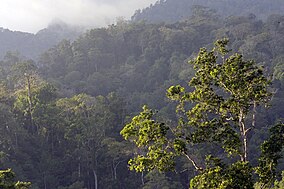Tangkoko Batuangus Nature Reserve
| Tangkoko Batuangus Nature Reserve | |
|---|---|
 | |
 Tangkoko Location in Sulawesi | |
| Location | Sulawesi, Indonesia |
| Nearest city | Bitung |
| Coordinates | 1°31′N 125°11′E / 1.517°N 125.183°ECoordinates: 1°31′N 125°11′E / 1.517°N 125.183°E |
| Area | 87 km2 |
| Established | 1981[1] |
| Visitors | 7,500 (in 2007[2]) |
| Governing body | Ministry of Forestry |
Tangkoko Batuangus Nature Reserve also known as Tangkoko-Batuangus Dua Saudara[3] is a nature reserve in the northern part of Sulawesi island of Indonesia, two hours drive from Manado. The reserve covers an area of 8,700 hectares and includes three mountains: Mount Tangkoko (1,109 meters), Mount Dua Saudara (1,361 meters) and Mount Batuangus (450 meters).[4]
Flora and fauna[]
The most common trees in the lowland rainforest of the park are species of the Palaquium genus, Cananga odorata and Dracontomelon dao.[5]
Tangkoko Batuangus Nature Reserve protects at least 127 mammal, 233 bird and 104 reptile and amphibian species. Of these 79 mammal, 103 bird and 29 reptile and amphibian species are endemic to the island.[6]
Threatened mammals include the Celebes crested macaque, of which about 5,500 remain on the island,[7] spectral tarsier, Sulawesi bear cuscus and Sulawesi dwarf cuscus.[2] Birds include the knobbed hornbill, Sulawesi hornbill and maleo.[8]
Conservation and threats[]
The first conservation area at Mount Tongkoko has been established in 1919. To this the Duasaudara area has been added in 1978, and the Batuangus and Batuputih areas in 1981, together encompassing a total of 8,718 hectares. Visitation is only allowed in the Batuputih area.[2]
Several Indonesian and international environmental organisations are involved with the conservation of the reserve, including Sulut Bosami, Wildlife Conservation Society and Tarantula.[6]
Habitat destruction and hunting pose serious threats to the reserve.[6] As result of hunting, between 1978 and 1993 the number of crested macaques declined by 75%, maleo birds by 90% and bear cuscus by 95%.[9] A survey of the three surrounding villages conducted in 2005 found that while the most frequently hunted species were rats, locals still hunted for macaques and cuscus both for meat and to be sold on the market.[10]
See also[]
References[]
- ^ Protected Planet: Tangkoko Batuangus Nature Reserve Archived 2012-03-16 at the Wayback Machine, retrieved 12 August 2011
- ^ Jump up to: a b c Kompas: Aset Sejarah Alam Dunia dan Rumah Satwa Sulawesi 30 April 2008 (in Indonesian)
- ^ Justine Vaisutis: Indonesia, Lonely Planet, 2007
- ^ "Taman Nasional Tangkoko". May 25, 2013.
- ^ Kurniawan et al (2008) "Association of dominated tree species in lowland tropical forest of Tangkoko Nature Reserve, Bitung, North Sulawesi ", in Biodiversitas, vol.9, nr.3
- ^ Jump up to: a b c Hyginus Hardoyo: "Nature lovers committed to preserve nature" in The Jakarta Post, 5 June 2008
- ^ Hyginus Hardoyo: "Watching wild animals at Batuputih Nature Tourism Park", in The Jakarta Post, 5 June 2008
- ^ Kyes et al. (2013) "Long-Term Population Survey of the Sulawesi Black Macaques (Macaca nigra) at Tangkoko Nature Reserve, North Sulawesi, Indonesia", in American Journal of Primatology Vol.75, issue 1
- ^ Bennett, Elizabeth: "Using wild resources in managed ecosystems" Archived 2013-12-31 at the Wayback Machine, IUCN, retrieved 31 December 2013
- ^ Onibala and Laatung (2007) "Bushmeat Hunting in North Sulawesi and Related Conservation Strategies (A case study at the Tangkoko Nature Reserve", in Journal of Agriculture and rural Development in the Tropics and Subtropics, nr.90
External links[]
![]() Media related to Category:Tangkoko Batuangus Nature Reserve at Wikimedia Commons
Media related to Category:Tangkoko Batuangus Nature Reserve at Wikimedia Commons
| Wikimedia Commons has media related to Tangkoko Batuangus Nature Reserve. |
- Protected areas of Indonesia
- Sulawesi
- Protected areas established in 1981
- 1981 establishments in Indonesia
